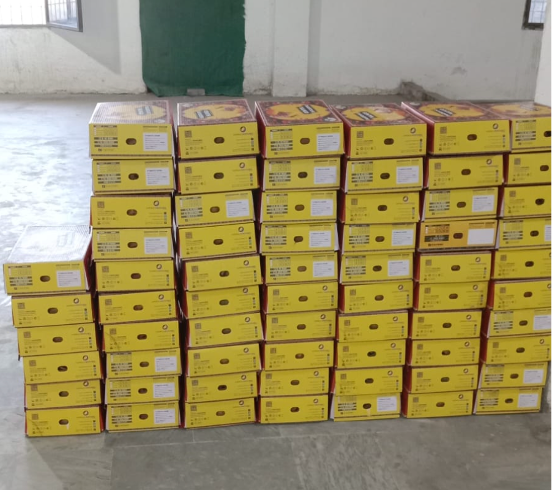ghazi52
PDF THINK TANK: ANALYST

- Joined
- Mar 21, 2007
- Messages
- 103,045
- Reaction score
- 106
- Country
- Location
.,.,
Apr 23, 2023
Basmati exports staged a strong rebound surging by 45 per cent to 64,274 tonnes in March from 44,137 tonnes in February despite 25pc damage to the last crop due to floods and heavy rains.
In dollar terms, rice exports jumped by 39pc to $69,475 in March from $49,875 in February.
Non-basmati export, however, registered a decline of 35.5pc to 328,344 tonnes in March against 509,271 tonnes in February. The fall in exports in dollar terms was around 21.3pc.
Total rice exports during March stood at 382,618 tonnes valuing $243,632, while Pakistan exported a total 2,907,322 tonnes of rice to earn $1,598,261 during the period July-March 2022-23.
Of them basmati variety was 428,404 tonnes worth $456,361 and non-basmati 2,478,918 tonnes valuing $1,141,900.
Rice trade expert Hamid Malik says with the current export trend Pakistan will be able to cross the $2bn export target.
An official of the Rice Exporters Association of Pakistan (Reap) said export figures in terms of quantity may be down but the way the crop has been affected, the foreign sales are comparatively satisfactory as exporters are getting fair prices.
“Ever high export prices and demand are there in the foreign markets. Though the crop is less in quantity but in terms of the value we are set to cross the $2bn mark.”
Last year Pakistan exported rice worth $2.5bn, historically the highest figure.
There is a very encouraging situation on the export front but local businesses are severely hit as scarcity of foreign exchange is preventing the import of machinery and material meant for value-addition.
“Machinery imports are stuck up. Things that are ultimately meant for exports are blocked. Letters of credit for planters, harvesters, and rice processing machines are not being opened. The companies working on sustainable production agriculture are being disallowed to import solar panels,” the official says requesting not to be named.
However, Momin Malik, Director of Seeds at Guard Agricultural Research and Services Ltd, says as basmati rice are getting a good price, particularly in the international markets, there is a growing trend of plating basmati this year instead of non-basmati varieties, which had been claiming the basmati acreage for the last few years.
Also due to delays in wheat harvesting because of late sowing as well as low temperatures in March slowing down the crop’s maturing process, the sale of rice seeds of coarse varieties has declined by over 10pc. For, he explains, the window for reaping a third crop of hybrid rice, between wheat and basmati rice, has narrowed down because of delay in wheat harvesting.
Basmati rice exports surge 45pc in March
DAWNApr 23, 2023
Basmati exports staged a strong rebound surging by 45 per cent to 64,274 tonnes in March from 44,137 tonnes in February despite 25pc damage to the last crop due to floods and heavy rains.
In dollar terms, rice exports jumped by 39pc to $69,475 in March from $49,875 in February.
Non-basmati export, however, registered a decline of 35.5pc to 328,344 tonnes in March against 509,271 tonnes in February. The fall in exports in dollar terms was around 21.3pc.
Total rice exports during March stood at 382,618 tonnes valuing $243,632, while Pakistan exported a total 2,907,322 tonnes of rice to earn $1,598,261 during the period July-March 2022-23.
Of them basmati variety was 428,404 tonnes worth $456,361 and non-basmati 2,478,918 tonnes valuing $1,141,900.
Rice trade expert Hamid Malik says with the current export trend Pakistan will be able to cross the $2bn export target.
An official of the Rice Exporters Association of Pakistan (Reap) said export figures in terms of quantity may be down but the way the crop has been affected, the foreign sales are comparatively satisfactory as exporters are getting fair prices.
“Ever high export prices and demand are there in the foreign markets. Though the crop is less in quantity but in terms of the value we are set to cross the $2bn mark.”
Last year Pakistan exported rice worth $2.5bn, historically the highest figure.
There is a very encouraging situation on the export front but local businesses are severely hit as scarcity of foreign exchange is preventing the import of machinery and material meant for value-addition.
“Machinery imports are stuck up. Things that are ultimately meant for exports are blocked. Letters of credit for planters, harvesters, and rice processing machines are not being opened. The companies working on sustainable production agriculture are being disallowed to import solar panels,” the official says requesting not to be named.
However, Momin Malik, Director of Seeds at Guard Agricultural Research and Services Ltd, says as basmati rice are getting a good price, particularly in the international markets, there is a growing trend of plating basmati this year instead of non-basmati varieties, which had been claiming the basmati acreage for the last few years.
Also due to delays in wheat harvesting because of late sowing as well as low temperatures in March slowing down the crop’s maturing process, the sale of rice seeds of coarse varieties has declined by over 10pc. For, he explains, the window for reaping a third crop of hybrid rice, between wheat and basmati rice, has narrowed down because of delay in wheat harvesting.




